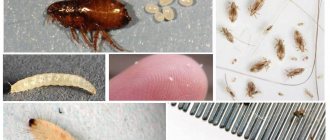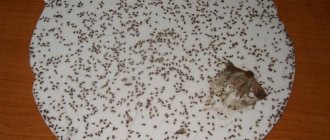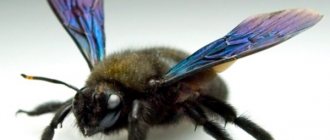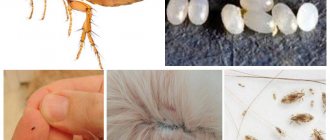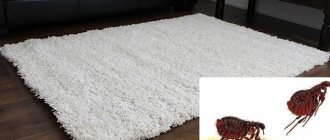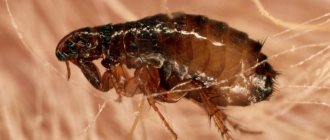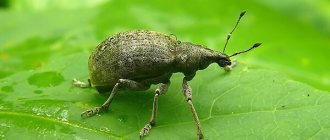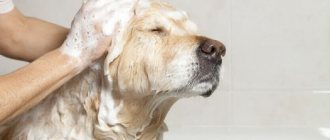Fleas in cats and dogs are a big tragedy. Not only do they harm our pets, but fleas also bite people. But treating fleas in cats and dogs at home is absolutely possible and not so difficult. Here you will learn how to remove fleas from a cat or dog, as well as whether fleas are transmitted from cats to humans. There are several external signs of how you can determine that your pet has fleas: - the cat (or dog) is constantly itching - redness on the skin - hair is falling out in places - the formation of ulcers and scratches at the bite sites
But before taking any measures to combat fleas, you need to be sure of the exact nature of the injuries. If your cat itches behind the ear or just the side, a tick may have attached itself to it.
Fleas are dangerous for animals because they can cause a number of diseases: - mycoplasmosis - helminthiasis - rickettsiosis - dermatitis - anemia - allergic reactions
Fleas on dogs
Dogs need to be walked regularly, so the risk of picking up parasites is high. This usually occurs upon contact with a source of spread (basement, entrance) or with a stray dog. Stray animals are carriers of all kinds of parasites and diseases, so do not allow your pet to come into contact with homeless relatives. The easiest way to protect your dog from fleas is to wear a special collar that repels pests with its composition, but this is only a preventive measure.
Fleas on cats
Although usually a cat seems to be a peaceful domestic inhabitant who never leaves the apartment, some cats really like to escape into the entrance hall, where they can pick up parasites on their fluffy fur. The consequences of such a walk appear after a few hours; the pet begins to actively itch, but cannot eliminate the cause of the itching. Sometimes traces of scratching become red, six in these places fall out, and occasionally it comes to bleeding scratches. Try not to let your cat into the entrance or onto the street, and make trips to the veterinarian using a carrier.
Prevention of infection
Preventive measures will help to avoid flea infestations and subsequent control of them. Dog owners should inspect and wash their pets more often, as they are outdoors every day and come into contact with other animals. But it is also recommended that owners of domestic cats periodically treat their pets and their resting places with special products.
The house should be wet cleaned regularly - parasitic insects do not like to live in clean areas. It is better not to keep the door to the entrance open, then the fleas will not have time to jump into the apartment. Pet owners should take care of their clothes and shoes and clean them after being outside.
Symptoms of fleas in an animal
At first, fleas may not show themselves, so it may seem that they appeared “out of nowhere.” If your pet begins to actively and incessantly scratch, this is the first alarming sign. Restlessness, licking and combing fur until bald spots are a clear sign of fleas. Examine the area where you scratched, see if there is any redness or scratches, and treat the affected areas. Spread the fur with your fingers in several places and you can determine the presence of fleas. How to save your pet from suffering?
Folk remedies for fleas for pets
To rid your pet of fleas, you can use the following safe folk remedies:
- Sagebrush. This product is completely natural and does not contain toxins. To prepare the decoction you will need one tablespoon of wormwood and boiling water. The herb is poured with hot water, after which the decoction should steep for several hours, and, of course, cool. The resulting mixture must be rubbed into the fur and skin of the animal.
- Eucalyptus leaves or tansy are suitable for the same method . But plant decoctions are most often used as prophylactic agents. If there are a large number of parasites, then they will not help here.
- If the infestation is severe, you can prepare a saline solution . Mix table salt and water in equal parts. The solution should be used to treat the carpets in the house, as well as the pet itself. The mixture should be left overnight and cleaned from the carpets in the morning using a vacuum cleaner. Pets are simply combed well to remove parasites.
- Fleas have an extremely negative attitude towards the pine smell . For pets, you can make special beds filled with spruce or pine shavings, and you can add dried wormwood to it.
- Using 3% vinegar essence and cologne , you can also get rid of parasites. The mixture is applied to the pet’s fur, and the animal is covered with polyethylene for several hours, excluding the head. After 30 minutes, the fleas need to be combed out over a basin and the contents poured into the toilet.
- Salt water may also help. You will need 1 pack of salt per bucket of water; you need to dissolve it well and then bathe the animal. Salt can be replaced with wormwood decoction , but you need to carefully ensure that the liquid does not get into the pet’s mouth.
- Along with bathing, you can treat the animal with tar or laundry soap .
Reviews
- Lera: We recently discovered that our dog has fleas. At the beginning of the first week, we bought special ointments in pharmacies, which ultimately led to nothing. Later, my grandmother advised me to make a lemon-based tincture. Surprisingly, we got rid of them very quickly.
- Margarita: Last summer we fought against fleas, tried to rid the cat of them, but all the methods and drugs recommended by the veterinarian did not help until we turned to traditional medicine. With the help of cedar oil, we were able to rid the cat of these pests.
- Oleg: I remember these disgusting insects were crawling in our apartment. We didn’t know what to do, so we turned to specialists and they recommended a spray. But unfortunately, he did not help us in any way. Therefore, we had to turn to our grandmother, who advised us to use wormwood as a flea remedy. Surprisingly, we got rid of them quite quickly.
Flea Control Chemicals for Pets
It is not always possible or convenient to use folk remedies, or you need to immediately get rid of annoying parasites, then chemical compounds come to the rescue. They come in different forms and methods of application, they are very effective, but they must be used with great care! We list the main flea remedies for dogs and cats.
- Anti-flea collars are suitable as prevention , but it is worth remembering that they have a limited validity period, usually several months. As the expiration date comes to an end, you need to buy a new collar. Cats are harder on collars than dogs, so this method is not suitable for everyone.
- There is a remedy similar in action to a collar - drops . They are applied to the animal’s withers, which will prevent it from licking off the active substances that repel and destroy fleas. The drops are quite effective and easy to use.
- More gentle means are powders . They contain a minimal amount of insecticides. Treatment with flea powder needs to be carried out several times, and its validity period is minimal, so it is not in great demand among pet lovers.
- Spray against fleas contains many insecticides and other harmful substances, so its effect is maximum, pests are eliminated instantly. But don't overdo it! Follow the instructions on the package, spray the required amount from the bottle and rub it into the dog or cat's fur. In order to protect your animal from chemical poisoning, wear a special collar to prevent licking of the fur. Spray the substance carefully, do not inhale its vapors and do not get it in the eyes of yourself or your pet!
Risk factors
The fleas that infect cats live in the grass. From there they jump on warm-blooded animals and feed on their blood. These blood-sucking parasites live on all continents, even Antarctica. A cat can become infected with fleas at any time of the year.
It is important to remember the reasons why a cat is at risk of contracting parasites:
- A cat that goes outside will definitely become infected with fleas. Therefore, you should not let your pet walk on its own.
- Unlike cats, domestic dogs should be walked 2-3 times a day. If a dog brings fleas home, then all other animals will pick them up. All pets should be treated for fleas regularly.
- A person can bring fleas into an apartment on his shoes or outerwear. Only regular treatment with anti-flea products will protect your pet.
- If the cat already had fleas, but the owner did not treat the pet, then the parasites will soon appear again. Fleas lay eggs in animal fur. New parasites can hatch from these eggs at any time.
- Fleas that have already entered the apartment will settle in the thick carpet. All carpets and cat beds should be thoroughly vacuumed.
- Fleas multiply especially actively in the heat, so in the summer you will have to treat your cat several times.
Flea infestations often lead to serious complications that are detrimental to the health of cats. Flea bites always cause severe pain and excruciating itching, and also provoke the development of dangerous diseases.
Complications of flea bites:
- Anemia is a condition in which a cat does not have enough blood due to a large number of parasites. The level of hemoglobin in the blood is greatly reduced. It develops when cats are not treated for fleas. Street animals are most often affected. Very young kittens, as well as weakened, sick and elderly animals can die from anemia.
- Flea dermatitis is an allergic reaction to the saliva of parasites that enters the skin during a bite. The pet experiences severe skin irritation, so the cat constantly licks. Her hair falls out and her skin becomes crusty. Infection easily penetrates damaged skin, which can lead to blood poisoning.
- Infectious diseases - fleas can infect pets with bartonellosis or rickettsia.
- Tapeworms - by licking, a cat can swallow fleas infected with tapeworms. Because of this, worms will begin to multiply in the intestines, the pet’s well-being will worsen, and then it will have to be treated not only for fleas, but also for worms.
Parasites are especially dangerous for pregnant and lactating cats. Fleas can harm not only the mother, but also the future offspring. But during pregnancy and lactation, you cannot treat your cat with anti-flea agents, because they are toxic. Treatment must be carried out before mating.
Up to 200 fleas can live on one cat. A caring owner should treat pets for parasites 4 times a year - every 3 months. If your cat has fleas, you need to carry out additional treatment.
We recommend the article: How to help a cat if he is coughing as if he is choking?
DIY flea shampoo
If you do not trust the composition of the flea shampoo sold in the pet store, or do not want to overpay, prepare your own anti-flea shampoo. For this you will need:
- baby soap;
- medium sized onion;
- egg yolk;
- calendula or chamomile.
The soap is grated using a coarse grater and filled with warm water. The resulting mixture must be brought to a boil to obtain a mass similar in consistency to jelly. You also need to add the grated onion there. Boiled chamomile (can be replaced with calendula) and egg yolk are poured into the finished product and mixed thoroughly. Lather the pet with shampoo, cover it with polyethylene and leave it for half an hour. Then everything is thoroughly washed off.
